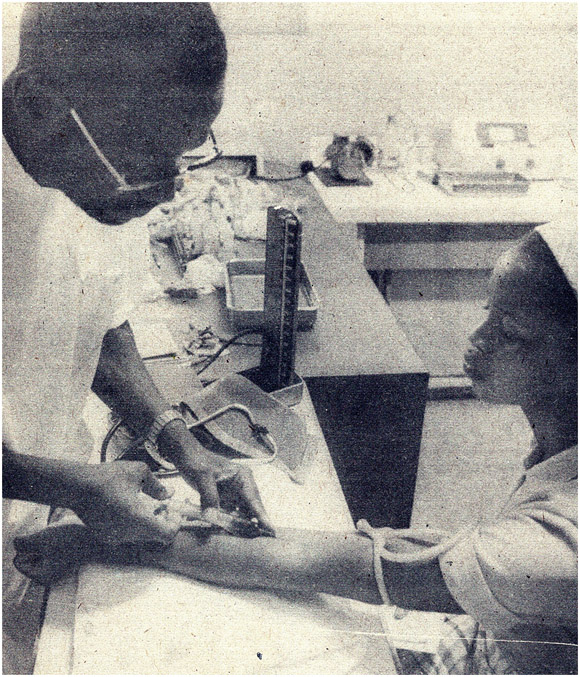Health: Press Reports and
Documents About HIV/AIDS
Unnumbered Dossier
![]()

Above: A Mozambican health worker drawing a blood sample from the arm of a patient sometime in the 1980s. The first case of HIV infection in the country was diagnosed in 1986.
From the mid-1980s onwards, Mozambique was very badly impacted by the global AIDS pandemic. In Mozambican Portuguese AIDS is known as SIDA (síndrome da imunodeficiência adquirida) and is referred to in this way in most of the reports in this dossier. The first case of HIV infection in Mozambique was diagnosed in 1986, and by December 1987 there were officially four cases, three Mozambicans and one foreigner. However, in the early years of the war with RENAMO, little media or state attention was paid to the spread of the syndrome, and the rate of infection was likely much higher than reported at the time. In 1988 the Ministry of Health under Fernando Vaz launched the country’s first three-year AIDS programme, funded by the World Health Organisation and the Swedish government.
There is little epidemiological data for HIV/AIDS before 1988, and after 1988 (until 2000) data collection focused mainly on Maputo’s central hospital and the cities of Chimoio, Tete, and Beira (along central transport corridors), resulting in a geographically distorted picture of early infection and mortality rates. Reports in late 1987 estimated the prevalence of infection at 0.9 percent in Maputo and Beira, and 2.2 percent in Nampula. In other African countries, a common pattern for the spread of HIV infection was that it began in the capital city and then spread into rural areas. However, in Mozambique it was the central region of the country that initially suffered the most severe rate of infection—in 1994 it was estimated at between four to seven times higher than the southern region, including Maputo. The central provinces were those most affected by the war, with large movements of displaced people and the presence of Zimbabwean troops guarding the Beira and Tete corridors. After the cease-fire in October 1992, the transport corridors were used by large numbers of truckers, attracting sex workers around such areas as border crossings; rates of infection seem to have increased as people began to move freely once again after the war ended.
This dossier includes over 50 newspaper and other reports specifically on HIV/AIDS in Mozambique itself (1986-1995), and a sub-folder with 30 items on the situation in Africa and Southern Africa (1985-1992). The material is journalistic in nature: for scientific accounts, see the published academic literature in both English and Portuguese. At present (2021) there is no comprehensive general historical account of the epidemic in Mozambique.
MHN Resources
Consolidated Downloadable Zipped Files
Click on the yellow folder image below to download a zipped file of the dossier of 54 plus 30 press reports and documents on HIV/AIDS in Mozambique, all in PDF format. New items will be added from time to time. This version of the dossier is dated 9 March 2021.
![]()



![Aluka: Struggles for Freedom [subscription required] Struggles for Freedom](imgs/aluka_200.png)



